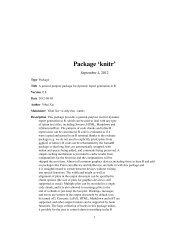Package 'openair'
Package 'openair'
Package 'openair'
Create successful ePaper yourself
Turn your PDF publications into a flip-book with our unique Google optimized e-Paper software.
104 selectByDate## multiple types and grouping variable and continuous colour scale## Not run: scatterPlot(mydata, x = "nox", y = "no2", z = "o3", type = c("season", "weekend"))# use hexagonal binning## Not run:library(hexbin)# basic use, single pollutantscatterPlot(mydata, x = "nox", y = "no2", method = "hexbin")# scatterPlot by yearscatterPlot(mydata, x = "nox", y = "no2", type = "year", method ="hexbin")## bin data and plot it - can see how for high NO2, O3 is also high\dontrun{scatterPlot(mydata, x = "nox", y = "no2", z = "o3", method = "level", x.inc = 10, y.inc = 2)}## fit surface for clearer view of relationship - clear effect of## increased O3\dontrun{scatterPlot(mydata, x = "nox", y = "no2", z = "o3", method = "level",x.inc = 10, y.inc = 2, smooth = TRUE)}## End(Not run)selectByDateSubset a data frame based on dateDescriptionUsageUtility function to make it easier to select periods from a data frame before sending to a functionArgumentsselectByDate(mydata, start = "1/1/2008",end = "31/12/2008", year = 2008, month = 1,day = "weekday", hour = 1)mydatastartendA data frame containing a date field in hourly or high resolution format.A start date string in the form d/m/yyyy e.g. “1/2/1999” or in ‘R’ format i.e.“YYYY-mm-dd”, “1999-02-01”See start for format.year A year or years to select e.g. year = 1998:2004 to select 1998-2004 inclusiveor year = c(1998, 2004) to select 1998 and 2004.
















